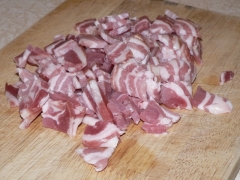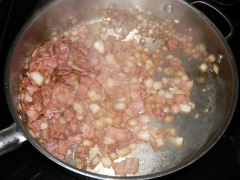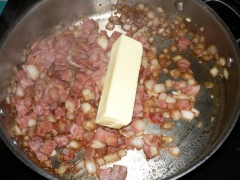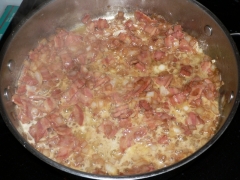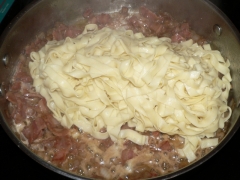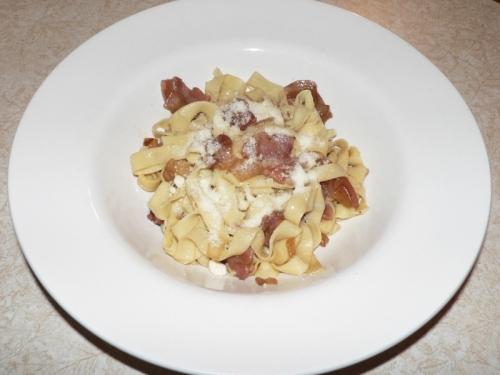Depending on who you talk to, carbonara may have eggs, cream, mushrooms, peas, garlic, pepper, and any of a half-dozen different kinds of cheese as the “proper” ingredients. I’m not a purist about it. I just care how it tastes. Oh, and “easy to make with what I already have” is pretty good, too.
Ingredients
½ lb pancetta
— or —
1 lb bacon
1 medium onion, diced
1 clove garlic, minced (that’s “diced really small” if you were wondering)
¼ lb butter (one stick)
¼ cup grated Parmesan
2 tablespoons dry parsley, or 3 tablespoons fresh (optional)
For fresh pasta
2 eggs
1 cup flour (plus a little more, depending on the size of the eggs)
1 teaspoon kosher salt
Otherwise
1 lb pre-made fettuccine or farafelle (bow-tie) pasta
Directions
To make the timing work well for this dish, it’s better to prep all the ingredients for the sauce,1 then make the pasta and get it into the pot, and finally make the sauce.
First chop the pancetta …
… into bite-sized pieces, about one inch square.
Then dice the onion.
Next mince the garlic and add it to the onion.
Finally, set out a stick of butter so it will start to warm to room temperature. If you don’t like the idea of leaving it out while you make the pasta, feel free to leave the butter in the fridge, it’s not that critical. Set everything aside and start on the pasta.
After putting the water on to boil, make the pasta from scratch and cut into fettuccine noodles. Don’t cut the noodles until the water is boiling. You can cut them and set them aside, but it’s much easier to put them straight into the water. Put a large pan for the sauce over high heat before putting the noodles in the water.
If you’re going with pre-made pasta you’ll have much more time to work on the sauce. If you’re fast with all the chopping steps above, you can do all the prep while the pasta cooks.
To start the sauce, put the pancetta (or bacon) in the pre-heated pan, turn it down to to medium, and cook until it’s starting to show browning around the edges. You can take bacon until it’s a little crispy, but don’t go much farther.
If you used bacon, you might want to pour off some of the fat at this point. Pancetta gives up much less fat, and reduces in size much less than bacon. That’s why the ingredients specify twice as much bacon as if you use pancetta. Some people won’t want that much bacon fat in the finished dish, but you at least want to leave a generous coating in the pan before adding the other ingredients.
Add the onion and garlic and reduce the heat further.
As you get more comfortable in the kitchen you’ll be able to keep the heat up higher and not burn anything. Until then, don’t risk scorching the garlic. It gets very bitter. Sauté until the onion is translucent, tossing or stirring occasionally.
If you’ve timed it right, the pasta should be ready about the time the onion is finished. Turn off the heat under the sauce but leave it over the burner, we’ll use the remaining heat to melt the butter.
Add the butter to the sauce pan, and pour the pasta into your colander. While the pasta is draining, stir the butter into the pancetta/onion mixture.
Add the pasta to the sauce pan.
Add the parsley (if you want it) and Parmesan and toss well to coat everything.
Serve with garlic bread or a nice crusty Italian or French bread.
1. Chefs will call this Mise en place. That’s just French for “set in place” — meaning get everything prepped and set out at one time before you start cooking.


